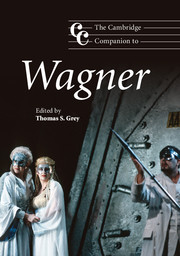Book contents
- Frontmatter
- PART I Biographical and historical contexts
- PART II Opera, music, drama
- PART III Ideas and ideology in the Gesamtkunstwerk
- 10 The urge to communicate: the prose writings as theory and practice
- 11 Critique as passion and polemic: Nietzsche and Wagner
- 12 The Jewish question
- PART IV After Wagner: influence and interpretation
- Notes
- Select bibliography
- Index
10 - The urge to communicate: the prose writings as theory and practice
from PART III - Ideas and ideology in the Gesamtkunstwerk
Published online by Cambridge University Press: 28 September 2011
- Frontmatter
- PART I Biographical and historical contexts
- PART II Opera, music, drama
- PART III Ideas and ideology in the Gesamtkunstwerk
- 10 The urge to communicate: the prose writings as theory and practice
- 11 Critique as passion and polemic: Nietzsche and Wagner
- 12 The Jewish question
- PART IV After Wagner: influence and interpretation
- Notes
- Select bibliography
- Index
Summary
Wagner had just turned twenty-one when his first published essay appeared, and he was busy with his last on the day he died. Writing for publication was a perpetual accompaniment to his working life. One has only to browse through a catalogue of his titles, and the image of an artist brooding with immense concentration over vast and intricate music dramas, each of them years in the making, gives way to a very different picture: a Wagner who dashed off anything from anecdotal squibs to solemn tracts whenever the impulse struck. This body of work is substantial enough that it cannot be left out of any account of the composer; and, since most of it bears on questions of operatic theory and practice, and much of it refers directly to Wagner's own operas, it virtually demands that we refer to it whenever we are thinking about the more familiar productions of Wagner's genius. Since an essay of this length cannot hope to introduce the themes and propositions of even a few of the major writings, my purpose instead will be to consider the question of their relation to the operas. What can we do with them? How should we read Wagner's published prose to help understand him as a composer and dramatist?
Much of his published writing sets out to answer this very question. In the characteristically melodramatic words of A Communication to My Friends, a semi-autobiographical essay of 1851, “I was burning to write Something that should take the message of my tortured brain, and speak it in a fashion to be understood by present life” (PW I:378; GS IV:331; the remark mediates, in this context, an apologetic reference to the “tortured” style of his recent theoretical essays and an exposition of the unrealized dramatic project Jesus of Nazareth).
- Type
- Chapter
- Information
- The Cambridge Companion to Wagner , pp. 177 - 191Publisher: Cambridge University PressPrint publication year: 2008

